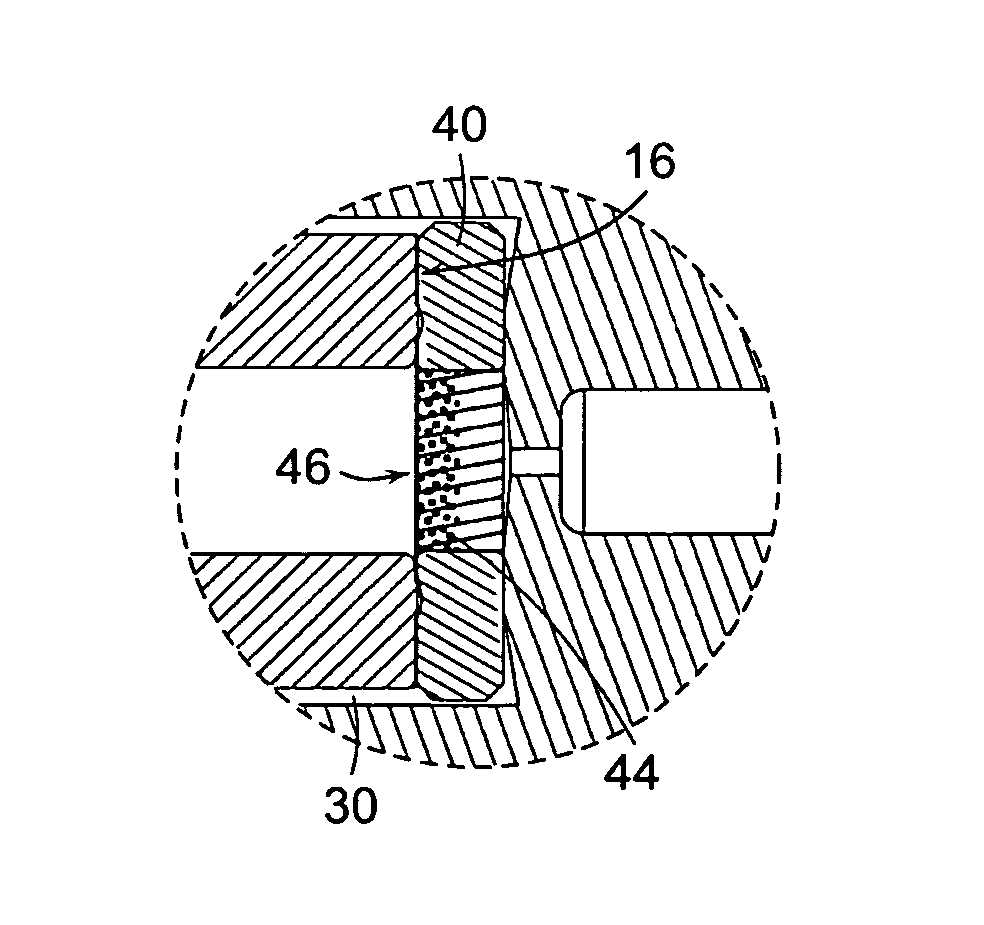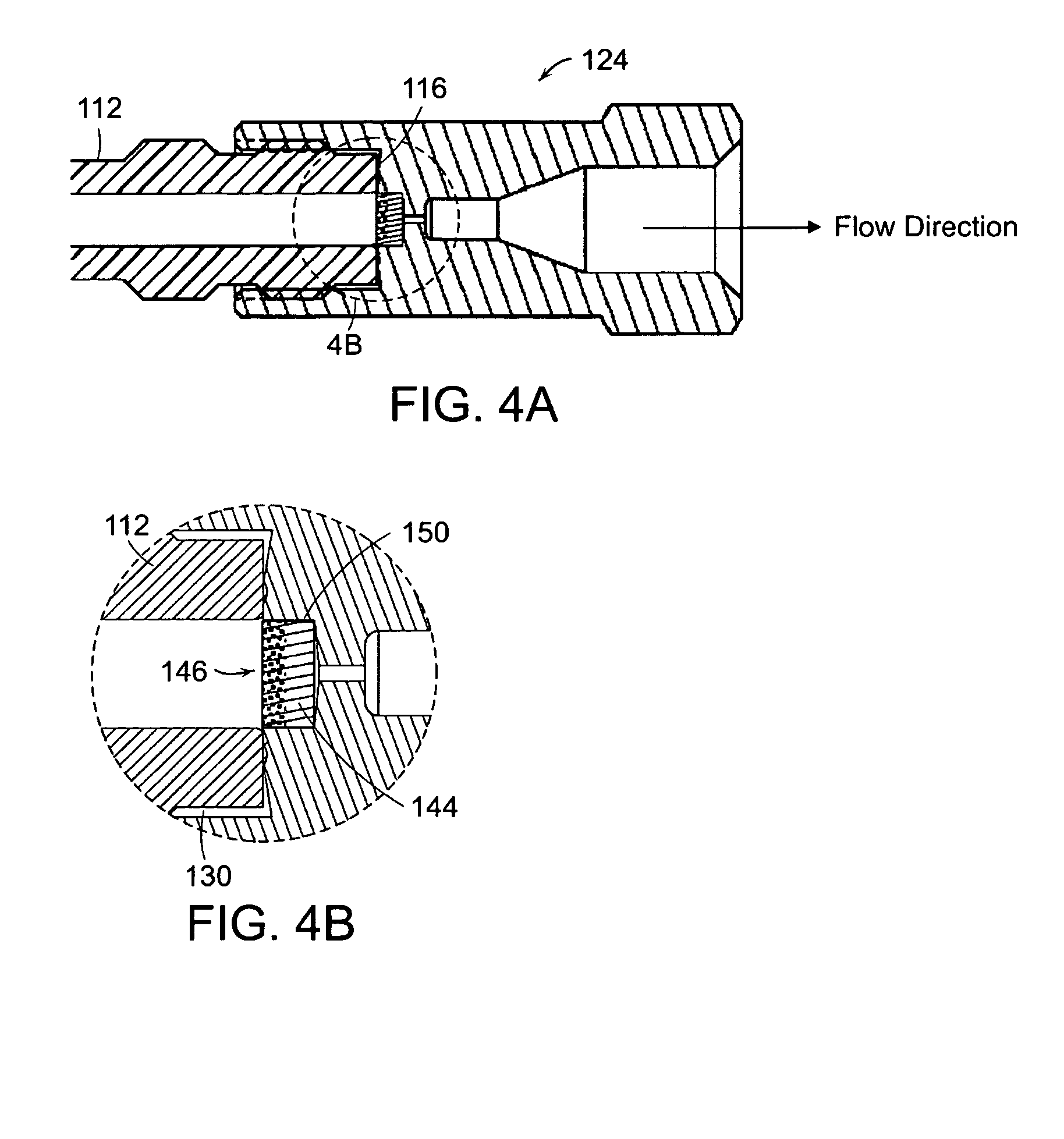Frit for high pressure liquid chromatography
a liquid chromatography and high-pressure technology, applied in the field of filters, can solve the problems of insufficient retention of particles less than 2.5 microns in diameter of filters, inability to achieve complete particle retention using conventional frits, and inability to guarantee retention under a given set of conditions, etc., to achieve the effect of improving part strength
- Summary
- Abstract
- Description
- Claims
- Application Information
AI Technical Summary
Benefits of technology
Problems solved by technology
Method used
Image
Examples
example 1
[0076]A porous support structure containing 3.5 micron secondary particles was filled as follows. A 0.5 media grade porous support structure was press fit into a circular planar ring (as shown in FIG. 3) that allows for a sealing surface. The sealing ring containing the porous support structure was placed into an outlet fitting. The outlet fitting was attached to an empty second end (outlet end) of a chamber (column). A 3 mL reservoir was attached to the first end (inlet) of the chamber. A tee was attached to the top of the reservoir. A pump was attached to the side opening of the tee. Then, 0.01 grams of 3.5 micron chromatographic packing materials was admixed and sonicated in 3 mL tetrahydrofuran (THF). The particle-solution was sonicated for 2 minutes. The particle-solution was poured or pipetted into the reservoir through the top opening of the tee. The particle-solution was topped off with approximately 2.2 mL of THF. The top opening in the tee, used to introduce the solutions,...
example 2
[0078]Frits containing 4 micron stainless steel particles were prepared as follows. A porous support structure (2.0 media grade sintered stainless steel) having a diameter of 2.1 mm and a thickness of 0.040 in. was press fit into a stainless steel sealing ring. The porous support structure was placed in a fixture whereby vacuum was drawn through the porous support structure. Narrowly sized particles (4 microns in diameter) were suspended in 10 mL toluene and mixed using a magnetic stir bar. A small volume of particle suspension was placed on the porous support structure and allowed to penetrate and pack into the void spaces within the support structure. The filled frit was wiped clean of excess particles and then sintered to 1900° F. for approximately one hour in a controlled H2 atmosphere to permanently immobilize the particles into a unified structure. Both 0.5 and 2.0 media grade frits were filled according to this process.
[0079]In Example 2, the described embodiment includes a “...
example 3
[0080]In the above examples, each of the frits preferably has a density of at least 50%. In other words, the void spaces or pores make up less than 50% by volume of the frits. The density of the frits increases after secondary particles are filled in the void spaces, thereby decreasing porosity.
[0081]In Example 3, depth of penetration was measured using 0.5 and 2.0 media grade porous support structures. For the 2.0 media grade porous support structure, the porosity of the unfilled structure was 32% (68% dense). For the 0.5 media grade porous support structure, the porosity of the unfilled structure was 19% (81% dense). Each support structure had a diameter of 2 inches and a thickness of 0.125 inches. Porosity was measured by comparing the weight of the porous support structure to the expected weight of a solid part of 316L stainless steel. Then, the porous support structures were slurry filled from one side with 4 micron stainless steel spherical particles (secondary particles) and ...
PUM
| Property | Measurement | Unit |
|---|---|---|
| size | aaaaa | aaaaa |
| diameters | aaaaa | aaaaa |
| size | aaaaa | aaaaa |
Abstract
Description
Claims
Application Information
 Login to View More
Login to View More - R&D
- Intellectual Property
- Life Sciences
- Materials
- Tech Scout
- Unparalleled Data Quality
- Higher Quality Content
- 60% Fewer Hallucinations
Browse by: Latest US Patents, China's latest patents, Technical Efficacy Thesaurus, Application Domain, Technology Topic, Popular Technical Reports.
© 2025 PatSnap. All rights reserved.Legal|Privacy policy|Modern Slavery Act Transparency Statement|Sitemap|About US| Contact US: help@patsnap.com



